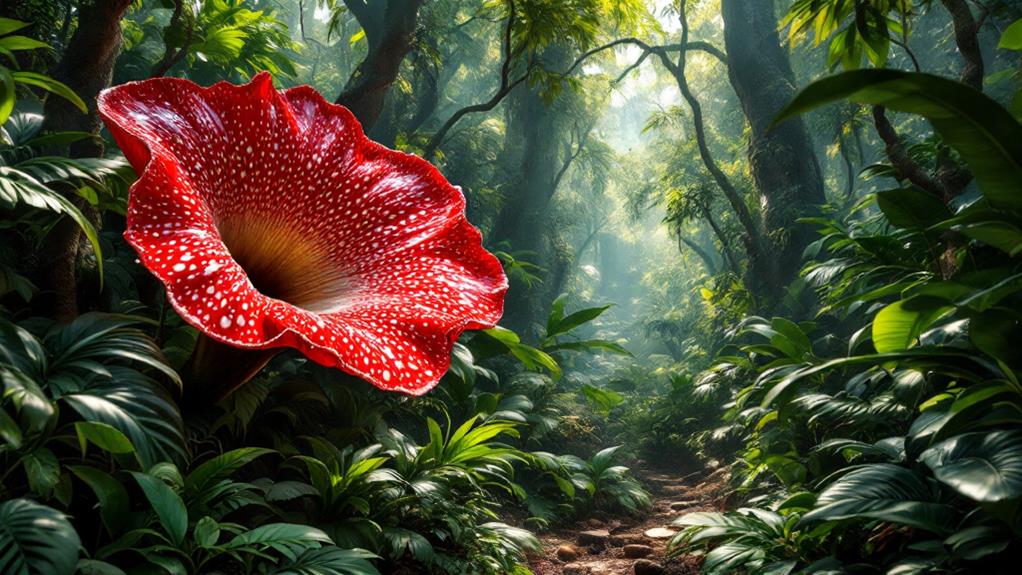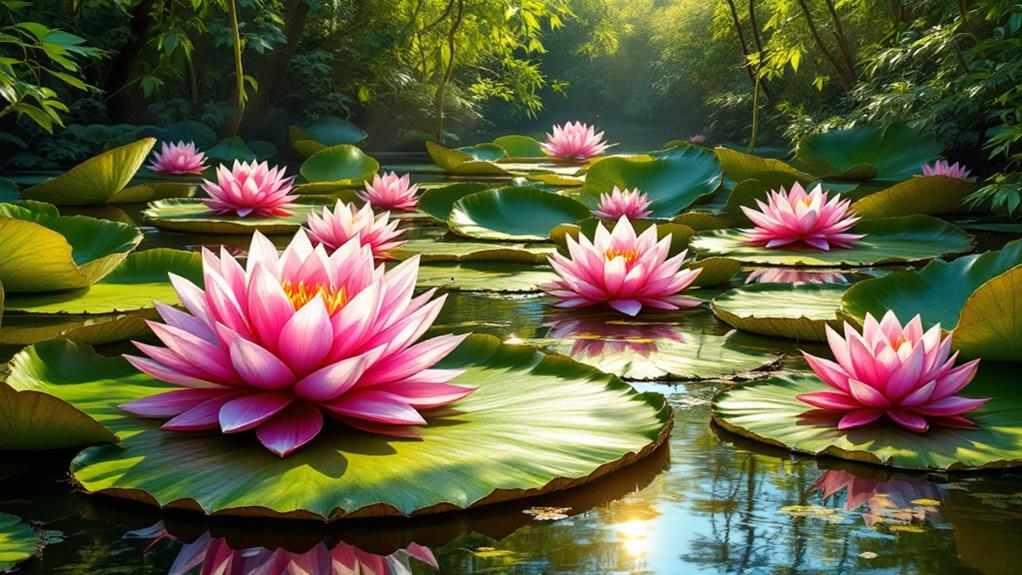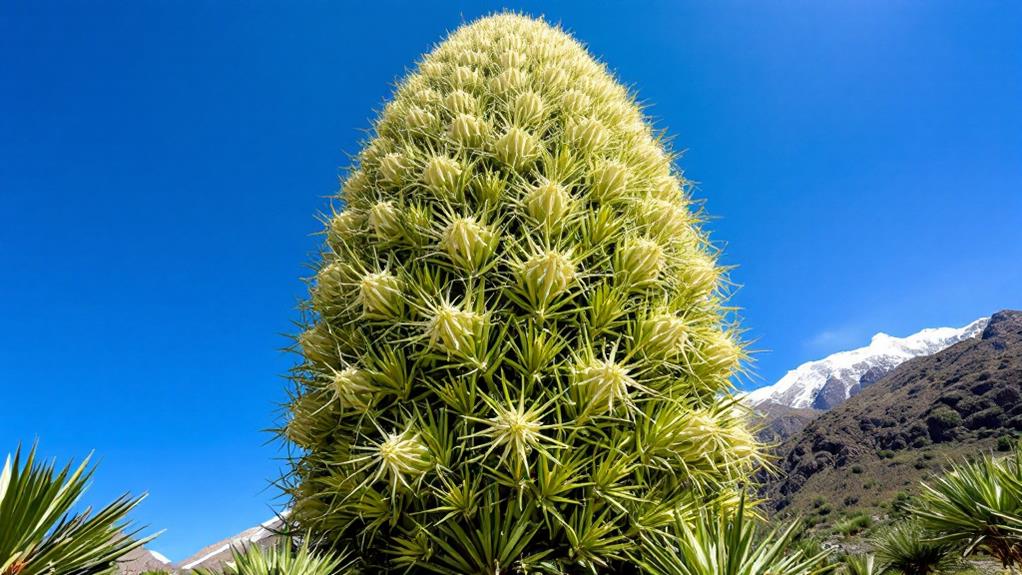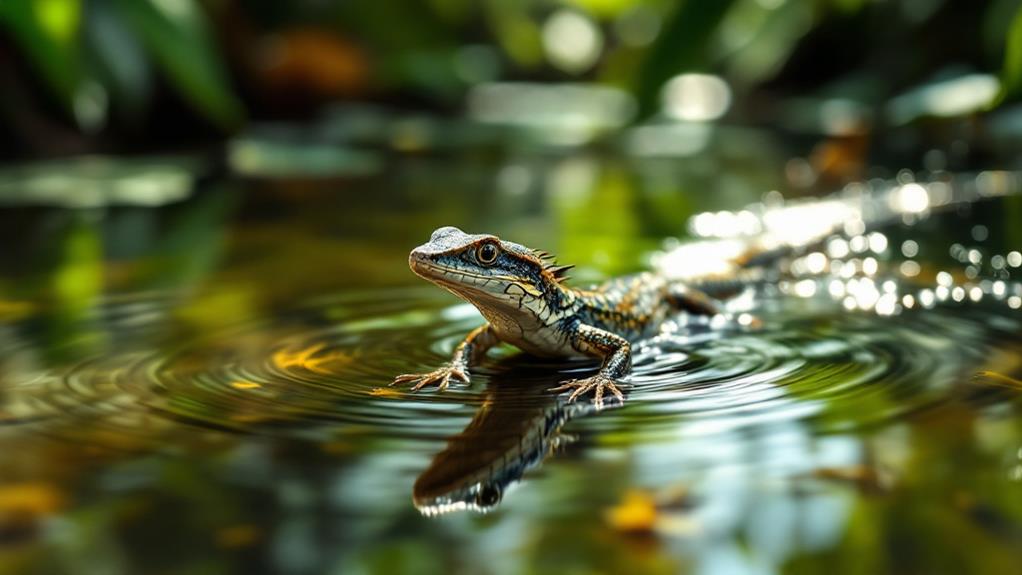The Largest Flowers on Earth: Nature’s Giant Blooms

You'll find giant blooms among the largest flowers on Earth, each with extraordinary features. The Rafflesia Arnoldii, known for its three-foot diameter and foul odor akin to rotting flesh, intrigues with its unusual pollination strategy. Meanwhile, the Titan Arum impressively rises over ten feet, attracting pollinators with its pungent scent. The Giant Water Lily offers striking ten-foot leaves, while the Talipot Palm waits decades to bloom once. Puya Raimondii reaches fifty feet high in the Andes, showing nature's grand designs. These botanical marvels captivate with unique life cycles and ecological roles, enticing you to uncover more wonders.
Rafflesia Arnoldii
Among the most fascinating wonders of the plant kingdom, Rafflesia arnoldii stands out due to its extraordinary size and unique characteristics. You won't find petals or leaves on this peculiar flower; instead, it's known for its enormous bloom, sometimes exceeding three feet in diameter. As you investigate its pollination strategies, you'll uncover it relies on a distinct method. Rafflesia emits a strong odor reminiscent of rotting flesh, attracting carrion flies that inadvertently become pollinators as they search for what they believe to be food.
This unusual floral trick is crucial for the survival of Rafflesia arnoldii because it lacks conventional floral parts. The flies, deceived by the scent, facilitate the transfer of pollen, ensuring the continuation of this giant bloom's life cycle. In addition to its intriguing pollination methods, there's interest in the potential medicinal properties of Rafflesia. Indigenous communities have long used it in traditional medicine, believing it helps treat fever and internal injuries. However, its scarcity and conservation status pose challenges for scientific validation. By understanding these aspects, you'll gain insight into why Rafflesia arnoldii captures the fascination of botanists and enthusiasts alike.
Titan Arum
Standing tall as a marvel of the natural world, the Titan Arum, or Amorphophallus titanum, commands attention with its impressive stature and unique features. Known as the "corpse flower" due to its infamous odor, it blooms rarely but with unforgettable impact. When you encounter this giant, you're drawn to its towering height, which can reach over ten feet. The Titan Arum habitat is primarily the rainforests of western Sumatra, where it thrives in humid, tropical conditions. This environment provides the perfect backdrop for its sporadic yet spectacular blooming cycle.
Imagine witnessing the intricate pollination process of the Titan Arum. It relies on the help of carrion beetles and flesh flies, attracted by the flower's pungent scent, which mimics decaying flesh. You can marvel at how this scent is vital for Titan Arum pollination, ensuring the continuation of this rare species. As you observe the flower, you'll notice its large, umbrella-like spathe, which opens to reveal a central spadix—an architectural wonder of nature. This extraordinary plant reminds you of the intricate relationships and adaptations that enable survival in the wild.
Giant Water Lily

The giant water lily, known as Victoria amazonica, captivates with its enormous floating leaves and delicate blooms. You'll find these iconic plants in the tranquil waters of the Amazon River basin, where their unique water lily characteristics truly shine. Their leaves can stretch up to ten feet in diameter, providing a striking platform for the beautiful flowers that emerge in the evening. The blooms start off a pure white and transform into a soft pink after pollination, creating a visual spectacle.
In understanding the water lily habitat, you'll appreciate how these plants thrive in slow-moving, shallow waters. They require warm temperatures and abundant sunlight, which makes the Amazon's tropical environment perfect for their growth. The underside of their leaves is covered in a web of ribs, providing the structural support needed to hold up to 65 pounds. This adaptation prevents them from sinking, allowing them to dominate the water's surface.
As you investigate the giant water lily's world, notice the delicate balance they maintain with their ecosystem. They offer shelter to aquatic creatures and help regulate water temperature, showcasing nature's incredible design in every aspect of their existence.
Talipot Palm
Majesty reigns supreme when you encounter the Talipot Palm, one of the tallest and largest flowering plants in the world. Standing up to 82 feet tall, this palm commands your attention with its immense size and unique lifecycle. Native to the Western Ghats of India and Sri Lanka, the talipot palm thrives in tropical climates, making its habitat lush and lively. You'll find these palms towering over the dense forests and sometimes in cultivated gardens where conditions are just right.
The talipot palm lifecycle is truly fascinating. It's a slow-growing marvel, taking 30 to 80 years to reach maturity. The pinnacle of its existence is when it blooms, producing an enormous inflorescence with millions of tiny flowers. This grand spectacle can extend up to 26 feet in diameter, a reflection of nature's grandeur. But here's the catch: the talipot palm flowers only once in its lifetime. After this incredible feat, the palm completes its lifecycle by fruiting and then ultimately dying. This rare blooming event is both a celebration and a farewell, leaving behind seeds to continue its heritage. Witnessing this event is a reminder of nature's rhythm and resilience.
Sunflower Giants

Grandeur finds a new meaning when you encounter the sunflower giants, the towering titans of the floral world. Imagine walking through fields where these magnificent blooms reach for the sun, some standing over 12 feet tall. As you investigate the world of sunflower cultivation, you'll uncover that achieving such heights requires a blend of the right conditions and careful nurturing. Rich, well-drained soil and plenty of sunlight are crucial, while regular watering guarantees they thrive.
Sunflower giants are not just about size; they boast an impressive array of sunflower varieties. From the classic yellow blooms to striking reds and oranges, each variety brings a unique flair to gardens and landscapes. The Mammoth Grey Stripe is a favorite, known for its enormous heads filled with seeds. Another popular choice is the Russian Giant, which can grow up to 15 feet tall, making it a true showstopper.
Incorporating these giants into your garden not only adds visual drama but also supports biodiversity, attracting bees and birds. As you cultivate your own sunflower giants, you'll join a legacy of gardeners who've been captivated by these extraordinary blooms for centuries.
Corpse Flower
Step into the intriguing world of the corpse flower, a botanical wonder that captures attention with its unique characteristics and overwhelming stench. Known scientifically as Amorphophallus titanum, this extraordinary plant boasts one of the largest blooms on Earth. You're instantly drawn—or perhaps repelled—by its infamous corpse flower odor, reminiscent of rotting flesh. This pungent aroma serves a fundamental purpose: attracting pollinators like carrion beetles and flesh flies, which are essential for the flower's reproduction.
As you investigate the corpse flower habitat, you'll find it tucked away in the dense rainforests of Sumatra, Indonesia. These tropical environments provide the warmth and humidity necessary for its growth. The plant's lifecycle is fascinating; it can take several years to bloom, and when it does, the spectacle lasts only a few days. During this brief period, the flower's spadix heats up, intensifying the odor and increasing the chances of pollination.
Witnessing a corpse flower in bloom is a rare event, often drawing crowds enthusiastic to see and smell this natural marvel. Its enchanting allure lies in its fleeting presence and the paradoxical beauty found in its repulsive scent.
Puya Raimondii

In the high Andes of Peru and Bolivia, you'll uncover Puya Raimondii, a plant that stands as one of the most remarkable botanical giants on Earth. This towering marvel, also known as the Queen of the Andes, can reach up to 50 feet in height, making it a spectacle in its natural habitat. Its impressive inflorescence consists of thousands of tiny blossoms, which play an important role in its pollination strategies. Different pollinators, including birds and insects, are drawn to these flowers, ensuring the plant's reproduction and survival in the harsh high-altitude environment.
You'll find that Puya Raimondii has a unique life cycle. It can take up to a century to bloom, after which it dies, leaving behind seeds that will hopefully sprout in the rugged landscape. However, the plant's future is uncertain due to threats from human activity and climate change. Habitat conservation is vital to protect these ancient giants. Efforts are underway to preserve their natural environment, promoting sustainable practices and awareness among local communities. By understanding and supporting these measures, you contribute to the survival of this extraordinary species and its breathtaking blooms.



